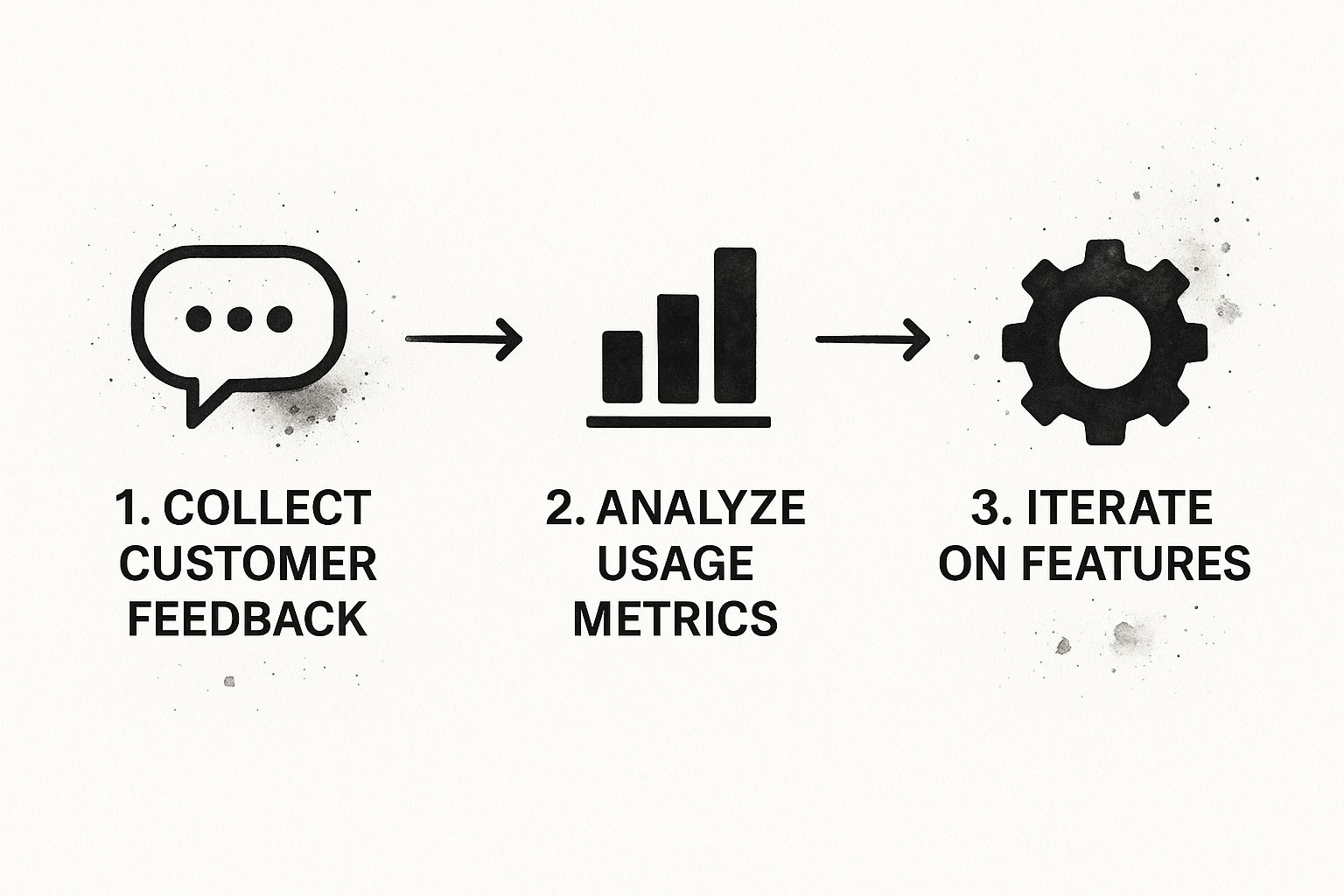Stop Lying to Yourself About Product-Market Fit
Stop lying about your metrics. This is a real founder's guide to product market fit validation that cuts through the noise and saves your startup.
Posted by
Related reading
Stop Asking Useless Survey Questions. Seriously.
Stop guessing. Here are 8 battle-tested ordinal survey question examples you can steal to get real customer insights instead of useless data.
Your Customer Feedback Is Useless. Here's Why.
Stop letting biased survey questions kill your startup. Learn to identify and fix common survey mistakes for brutally honest and actionable customer feedback.
Your Customers Are Lying to You (And It's Your Fault)
A no-BS guide on how to collect feedback from clients. Learn to ask the right questions and use insights to build a product people actually want.
Your metrics dashboard is a work of art. Signups are up. Weekly actives look "promising." You’ve cherry-picked the perfect chart for your next investor update. But you’ve got that knot in your stomach because you know the truth: you’re building a ghost ship.
People come aboard, click around a few times, and then vanish forever. Your churn is a leaky bucket, and the "engagement" is just new user confusion. You're celebrating vanity metrics to avoid the terrifying reality that nobody needs what you’ve built.
Ignore your customers, and you’ll be lucky to survive the quarter.
Your 'Good' Metrics Are Probably Lies
Let's be real. You're drowning in denial, celebrating numbers that don't pay the bills. That spike in website traffic from a guest post? Meaningless if none of them convert. Those 1,000 new signups? Worthless if they all churn by day seven. You're running a feature factory for users who never come back, burning cash on a product nobody would miss.
This isn't an abstract concept. It's the startup graveyard.
The Delusion of Vanity Metrics
The core problem isn't your product; it's your addiction to feeling productive. It’s easier to ship another feature than it is to face the brutal signals from the market. Vanity metrics are the sugar high of the startup world—a quick rush followed by an inevitable crash.
Stop obsessing over metrics that don't tie directly to retention or revenue. The only way to see past the noise is with a brutally honest business performance metrics dashboard that tracks what actually matters.
The Only Signal That Matters
Product-market fit isn't finding people who say your idea is “cool.” It’s finding users who would be genuinely pissed off if you shut down tomorrow. These people don't just use your product; they rely on it. Your mission is to go from a "nice-to-have" vitamin to a "can't-live-without" painkiller.
That feeling is visceral. It doesn’t show up in a download count. It shows up in the frantic support tickets when your server is down for five minutes.
Takeaway: Stop building features for ghosts and start finding the users who would pay to keep you alive.
The One Question That Defines Your Survival
Forget your 50-question survey. You’re not an academic researcher; you’re a founder burning cash. Most of that data is just polite noise you’ll use to justify your existing biases.
You need a signal so strong it’s deafening. And it comes from one, single question that separates a real business from an expensive hobby. Sean Ellis, the guy who coined "growth hacking," gave us the ultimate litmus test.
It's this: “How would you feel if you could no longer use this product?”
The choices are brutal and simple:
- Very disappointed
- Somewhat disappointed
- Not disappointed
That’s it. No room for "it's nice." Just a raw, gut-level reaction that tells you everything.
The 40% Pain Threshold
Here’s where founders screw up. They see a bunch of "somewhat disappointed" responses and call it a win. I've been there. My team once celebrated a 70% "somewhat disappointed" score, convincing ourselves we were on the right track.
We were dead wrong. We'd built a vitamin.
The magic number is 40%. If at least 40% of your users say they would be “very disappointed” without your product, you’ve found a real signal. Anything less than 40% means you’re a ghost. You exist, but nobody would notice if you were gone. This isn't just a metric; it's your north star for navigating away from the startup graveyard.
"Somewhat disappointed" is a polite "no." It means they'd find an alternative in five minutes and forget you ever existed. “Not disappointed”? They’ve already forgotten you. Dig into these real-world examples of successful product-market fit to see what this tribe looks like.
Your job is to become obsessed with the “very disappointed” group. Their feedback is gold. Everyone else’s is noise. To get that gold, you need to ask the right questions for market research.
Decoding User Bullshit
Founders hear what they want to hear. Here’s a quick translation guide for the polite lies people tell you.
| What You Hear | What It Actually Means |
|---|---|
| "This is a really cool idea!" | "It’s interesting, but I have no problem this solves." |
| "I'd definitely use this." | "I would use this... if it were free and I remembered it existed." |
| "How much will it cost?" | "I'm trying to figure out how to say it's too expensive." |
| "Let me know when it's ready." | "This is a polite way to end the conversation." |
Talk is cheap. Desperation is validation.
Takeaway: Stop asking people if they like your product and start measuring how painful it would be to lose it.
Stop Building a Beautiful Coffin for Your Idea
That grim 90% startup failure rate? It’s not because of slick competitors or a lack of funding. Those are just symptoms. The real killer is founders building something nobody gives a damn about.
You fall in love with your solution—a beautiful, intricate key. But you never bothered to find a lock it could open. You mistake polite nods in a coffee shop for genuine buying intent. You're not building a business; you're just building a beautiful coffin for your idea. That’s the brutal reality of failed product-market fit validation.

This isn't a nightmare; it's a statistic. Of the 30,000 new products launched each year, 95% fail. Why? They solve a "problem" that isn't a real problem for a market that won't open its wallet.
The Feature Factory Death Spiral
What does this failure feel like from the inside? A frantic, desperate scramble called the "feature factory." When metrics are flat, the team panics. Instead of talking to users, they retreat to the comfort of shipping more code. The logic is tempting but dead wrong: "If we just add one more thing, they'll finally get it!"
This leads to a bloated, confusing product that’s nothing to anyone. Each new feature is just another layer of denial, another excuse to avoid the scary work of asking real customers what they actually need. You need a solid feature prioritization framework to break the cycle.
The feature factory isn't productivity. It's a team that has lost its way, desperately throwing spaghetti at the wall and hoping something sticks. You're not building a business; you're just running an expensive funeral for your idea.
Takeaway: Stop building a beautiful coffin and start finding out if anyone actually needs a painkiller.
Stop Innovating and Start Finding the Problem
Forget the myth of the brilliant founder with a divine vision. That story sells magazines, but it’s a lie. The giants you worship—Slack, Airbnb, Instagram—didn’t start with a perfect idea. They stumbled into a real-world problem and were relentless about proving their solution wasn't just a hallucination.
Your precious, unique idea? It’s probably worthless. And that's fantastic news. Novel ideas are impossible to validate. You don't need to invent something; you need to become obsessed with a problem someone is already desperate to solve.

The Myth of the Straight Line
Let's tear down those polished origin stories. They're about messy, painful pivots driven by real-world feedback.
Slack was a failure. The team was building a video game called Glitch. The internal chat tool they built to communicate was just a side project. The game failed, but they realized their tool solved a much bigger problem. They followed the market's pull, not their original vision. You can see this pattern repeat in these PMF examples from tech giants on vivatechnology.com.
Airbnb’s founders sold cereal boxes to keep the lights on. They didn't double down on their "vision." They got scrappy and listened. They followed the problem, not their ego.
Founders fall in love with their solution. The market only cares about its problem. Your job is to be the world's expert on their problem, not your product. The market pulled the product out of them. That's product-market fit validation.
Follow the Pain, Not the Plan
Your five-year plan is worthless until you've found a problem so acute people are already trying to solve it with duct tape and spreadsheets. That’s your entry point. Look for the clumsy workarounds and frustrated forum posts.
- Where’s the spreadsheet? If your target customer uses a massive, complicated spreadsheet to manage something, you’ve found a pocket of pain. That spreadsheet is your first feature roadmap.
- What’s being hacked together? Are people stringing together five different free tools to accomplish one job? That’s a massive sign of a deep, unmet need. They’ve already validated the problem for you.
- Who is complaining the loudest? Go to Reddit and industry forums. Find the angry rants. Inside that frustration is a blueprint for a product people will actually pay for.
Stop trying to invent the future. Find someone in agony and offer them relief. That’s the whole game.
Takeaway: Your market doesn’t care about your brilliant idea; it only cares about its agonizing problem.
Your No-Excuses Roadmap to Finding PMF
Alright, no more theory. Product-market fit validation isn't a dark art. It’s a gritty process of exposing your fragile idea to the market's brutal reality—as quickly and cheaply as possible. Stop hiding behind your ideal customer personas. Find the people whose problem is so painful they’re already fixing it with duct tape.
Identify the Bleeding Neck Problem
Stop looking for compliments and start hunting for pain. You need a "bleeding neck" problem—so urgent people will grab anything to stop the bleeding.
How do you find it? Get out of your office.
- Shadow real users: Don't ask what they want. Watch them work. Pay attention to their frustrated sighs and clumsy workarounds. That's gold.
- Interview for pain, not solutions: Never ask, "Would you use a product that does X?" It's a useless question. Ask, "Tell me about the last time you tried to do Y." The more emotion you hear, the closer you are.
- Find the money: Is anyone already paying to solve a version of this problem? If not, it’s just an annoyance.
This is the loop you live in: collect raw feedback, analyze what users do, and iterate relentlessly.

This isn't a checklist; it's a cycle you repeat until the market starts ripping the product out of your hands.
Run Cheap, Ugly Tests
Before you write a single line of production code, test your assumption: will someone give you something valuable—money, time, reputation—for your solution? Forget a polished MVP. Get to the truth with minimum effort.
Your goal isn't to build a product. Your goal is to run an experiment that proves people need your product. A landing page that collects pre-orders is infinitely more valuable than a perfect MVP nobody uses.
Here are a few low-cost tests that get you hard data:
- The "Coming Soon" Landing Page: Describe the pain and your solution. The only CTA should be "Pre-order now for 50% off." Email signups are a weak signal; credit card numbers are the truth.
- The Concierge MVP: Solve the customer's problem manually. It's unscalable and exhausting, but it's the fastest way to learn what a real solution needs.
- The "Wizard of Oz" Prototype: Build a simple front-end, but have humans manually execute everything on the back end. The user thinks it’s automated; you’re just pulling levers behind a curtain.
As you test, understand the best practices for measuring Product Market Fit so you know when you've actually hit the mark.
Takeaway: Validate the problem with conversations, then validate the solution with commitments.
The Final Gut Check Before You Bet the Company
https://www.youtube.com/embed/O1As2zxy0es
You’ve run the surveys. The data looks good. Your Sean Ellis score is north of 40%. You’re feeling that dangerous mix of excitement and relief.
Stop. Before you dump your remaining capital into scaling, you need one last, critical filter: the founder’s gut check. Step away from the spreadsheets and look for the raw, human signals that are impossible to fake.
Beyond the Numbers
True product-market fit isn't a number; it’s a feeling. It's the market pulling the product out of you.
Are users finding creative ways to use your product you never imagined? Are they rigging up makeshift integrations with Zapier to wedge your tool deeper into their lives? That's not a bad UI; it's desperation. It means they need what you've built.
Another powerful signal? Anger. Not polite feature requests. I mean genuine frustration when your service is down for five minutes. An empty inbox during an outage is a terrifying sign of indifference. A flood of “WHERE IS MY STUFF?!” emails? That’s the beautiful sound of a customer base that can't function without you.
Indifference is the silent killer of startups. Passion, even when it’s angry, is proof that you matter. You want users who would be pissed if you disappeared, not ones who wouldn't notice.
The Unmistakable Signals Checklist
Before you bet the company, run through this blunt checklist. This is the art that validates the science of your product market fit metrics. If you can't check off at least half of these, your survey data might be a lie.
- Organic Word-of-Mouth: People are telling friends about you without you bribing them.
- Accelerating Growth: Your growth isn’t a straight line; the boulder is starting to roll downhill on its own.
- "Hacks" and Workarounds: Users are bending your product in weird ways to solve problems you never considered.
- Inbound Press/Interest: Bloggers and investors are reaching out to you.
- Outage Panic: Your customers are genuinely upset when your service is down.
- Unsolicited Testimonials: You’re getting heartfelt "you saved my day" emails you didn't ask for.
This isn’t about metrics; it’s about momentum. It’s the undeniable feeling that you've tapped into something real.
Takeaway: Stop looking for confirmation in your spreadsheets and start looking for proof in your customers' passion.
Stop drowning in feedback noise and let Backsy’s AI automatically find the painful problems your customers will pay you to solve.